6 Blue Sky and White Clouds Photography Tips for Stunning Photos
Capturing the perfect blue sky and white clouds photograph can transform any ordinary scene into a breathtaking masterpiece. Whether you’re photographing landscapes, cityscapes, or outdoor portraits, a vibrant sky can enhance the depth, mood, and beauty of your images. These photographs are also ideal for creating photo on canvas artwork that brings the serenity and expansiveness of the outdoors into your home. Below are six practical tips to elevate your sky photography skills.
1. Shoot During the Golden Hours
Timing is crucial for capturing striking sky images. The golden hours—shortly after sunrise and just before sunset—offer soft, warm light that enhances the blue hues of the sky while adding dimension to clouds. During these hours, the sunlight interacts with cloud layers, creating captivating textures and subtle color gradients that can make your photos more dynamic and visually appealing when printed on canvas.
2. Use a Polarizing Filter
A polarizing filter is a game-changer for sky photography. It helps reduce glare, enhance the contrast between clouds and the blue sky, and make colors pop without heavy post-processing. By rotating the filter, you can adjust the intensity of the blue and ensure the white clouds remain crisp and defined. This technique is especially effective when planning to showcase your image as a photo on canvas, where color vibrancy and clarity are key.
3. Experiment with Different Angles and Perspectives
Most photographers focus on a horizontal view of the sky, but exploring unconventional angles can add uniqueness to your shots. Try low-angle shots to emphasize vast cloud formations or shoot from elevated positions to capture patterns across a landscape. Playing with perspective not only creates more engaging photos but also ensures that your canvas print has a captivating composition that draws the viewer in.
4. Pay Attention to Weather Patterns
Not all skies are created equal. To capture striking blue and white contrasts, observe weather forecasts and identify days with partial cloud cover and clear visibility. Fluffy cumulus clouds on a bright blue sky often yield the most visually appealing compositions. Stormy skies or overcast conditions can also create dramatic, moody images, but they may not produce the classic “blue sky with white clouds” look. Choosing the right day ensures your canvas print has the uplifting and vibrant quality that most viewers love.
5. Balance Exposure and White Balance
Proper exposure is essential when photographing skies to avoid washed-out clouds or overly dark blues. Start by using a smaller aperture (f/8–f/16) to keep both the clouds and landscape in focus. Adjust your ISO for optimal clarity without introducing noise. Setting the correct white balance—either “Daylight” or manually adjusting—prevents color shifts that can dull the natural blues and whites, ensuring your image is ready for high-quality canvas printing.
6. Post-Processing Enhancements
Even the best shot can benefit from subtle post-processing. Adjusting contrast, saturation, and clarity can enhance the visual separation between clouds and sky, giving your photo more depth. Be careful not to over-edit; the goal is to maintain a natural appearance. If your ultimate aim is to create a photo on canvas, gentle editing ensures the printed colors remain true to the digital file while bringing out the sky’s natural brilliance.
Blue sky and white clouds photography is a rewarding pursuit that can elevate any landscape or outdoor scene. By shooting during golden hours, using a polarizing filter, experimenting with angles, monitoring weather patterns, balancing exposure, and refining post-processing, you can capture breathtaking images worthy of display. Whether for personal enjoyment or as a photo on canvas artwork, these tips ensure your sky photos make a lasting impression, filling any space with the serene beauty of nature.
Recent Posts
-
Top 5 Affordable Canvas Print Ideas for Your Children's Room
When it comes to decorating your child's room, it's important to create a space that feels as fun, p …8th Dec 2025 -
Common Mistakes to Avoid When Ordering Panoramic Canvas Prints
Panoramic canvas prints are an amazing way to showcase breathtaking landscapes, family memories, or …8th Dec 2025 -
Cheapest Canvas Prints Australia: Ideal Gift Ideas That Won’t Break the Bank
Finding meaningful gifts doesn’t have to drain your wallet—especially when personalised decor is mor …5th Dec 2025
